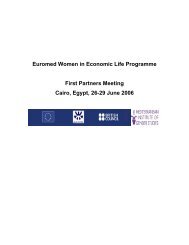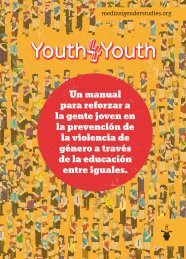react to domestic violence
react to domestic violence
react to domestic violence
Create successful ePaper yourself
Turn your PDF publications into a flip-book with our unique Google optimized e-Paper software.
2 THE CASE OF CYPRUS<br />
2.1 Defining Domestic Violence<br />
According <strong>to</strong> the United Nations Beijing Platform for Action, the term “<strong>violence</strong> against women” means any act<br />
of gender-based <strong>violence</strong> that results in, or is likely <strong>to</strong> result in, physical, sexual or psychological harm or suffering<br />
<strong>to</strong> women, including threats of such acts, coercion or arbitrary deprivation of liberty, whether occurring in<br />
public or private life” (United Nations 1996:73f.).<br />
Domestic <strong>violence</strong> is the most common form of <strong>violence</strong> against women and involves a pattern of abusive and<br />
threatening behaviours that may include physical, emotional, economic and sexual <strong>violence</strong> as well as intimidation,<br />
isolation and coercion. The purpose of <strong>domestic</strong> <strong>violence</strong> is <strong>to</strong> establish and exert power and control<br />
over another; and men most often use it against their intimate partners, such as current or former spouses,<br />
girlfriends, or dating partners. 1 Intimate partner <strong>violence</strong> is an epidemic of global proportions that has devastating<br />
physical, emotional, financial and social effects on women, children, families and communities around<br />
the world.<br />
Violence against women is a structural violation of women’s human rights and is recognised as such by international<br />
human rights instruments. General Recommendation No. 19 of the Committee of the Convention on the<br />
Elimination of All forms of Discrimination against Women (CEDAW) states that “Gender-based <strong>violence</strong> against<br />
women is <strong>violence</strong> that is directed against a woman because she is a woman or that affects women disproportionately.”<br />
According <strong>to</strong> the Beijing Platform for Action (1995), which has been endorsed by all EU Member<br />
States, <strong>violence</strong> against women “is a manifestation of the his<strong>to</strong>rically unequal power relations between men<br />
and women, which have led <strong>to</strong> domination over and discrimination against women by men and <strong>to</strong> the prevention<br />
of women’s full advancement”.<br />
Violence against women is rooted in a system of practices and laws which sanction men’s rights and active<br />
attempts <strong>to</strong> maintain dominance and control over women. 2 Domestic <strong>violence</strong>, as a form of <strong>violence</strong> against<br />
women, involves a male perpetra<strong>to</strong>r and a female victim in the majority of reported <strong>violence</strong>, and constitutes<br />
a reflection of unequal power relationships between men and women. 3<br />
In Cyprus, according <strong>to</strong> the Violence in the Family (Prevention and Protection of Victims) Laws, <strong>violence</strong> in the<br />
family “means any act, omission or behaviour which causes physical, sexual or mental injury <strong>to</strong> any member<br />
1 S<strong>to</strong>p Violence against Women: A project by the Advocates for Human Rights. [www.s<strong>to</strong>pvaw.org]<br />
2 Maynard, M. (1989) ‘Privilege and Patriarchy: Feminist thought in the nineteenth century’, in S. Mendus and J. Rendall (eds.),<br />
Sexuality and Subordination. London, Routledge, pp. 221-247.<br />
3 Maynard, M. and Winn, J. (1997) ‘Women, Violence and Male Power’ in Robinson, Vic<strong>to</strong>ria and Richardson, Diane (eds.), Introducing<br />
Women’s Studies. Macmillan Press; 2nd Revised edition, p. 180.<br />
2







